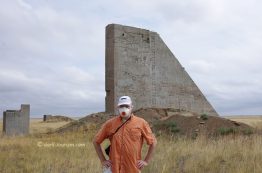| |
Strategies and Anniversaries
| |
 |
Hello subscribers!
Quite a few new ones have joined since last time, so let me say: welcome! I hope you’ll enjoy the content.
Since last week, three new posts have gone up on the new blog. One, featuring the photo here, is about the “nuclear landscapes of the Polygon”, aka Semipalatinsk Test Site (STS), in a remote region in north-eastern Kazakhstan, where the Soviet Union used to conduct the majority of its nuclear tests during the Cold-War era. This post featured a ‘landscape architectural’ proposal by Andrey Chernykh that was part of a master’s thesis at the University of Toronto, Canada. The proposal outlined several ‘interventions’ that could commodify the relics and landscape features of the STS for visitors. But it obviously remained just an academic proposal. Obtaining funding for such ideas will never be easy. The post also highlighted some of the photos I took myself when I visited the Polygon in 2011. It’s one of the most remote and difficult to access dark places in the world, but a top-notch DT attraction nonetheless (hence it also featured in the “Stans” episode of that Netflix series “Dark Tourist”).
On Friday, a shorter post also went up to mark the birthday of Anne Frank. This time I was reusing a photo and text I had already posted on the same date two years ago on my purged DT page on Facebook. It showed an Anne-Frank statue in Amsterdam not far from the world-famous Anne Frank House, which is one of the most visited dark-tourism sites on the planet.
Finally, yesterday’s extra post is one with a link to current affairs, namely the Black Lives Matter protest wave in the USA and beyond that was triggered by the recent killing of George Floyd by police in Minneapolis. Amongst the actions of protesters was the disfiguring and/or toppling of statues/monuments that celebrate certain historical figures associated with the USA’s long dark legacy in slavery, racial segregation and repression. Yet I argued the point that there are alternatives to iconoclastic destruction, as demonstrated e.g. by that Stalin plaque in Vienna from 1949 that in later years was joined by an additional plaque that put the older one into perspective and mentioned the many victims of Stalinism in order to provide a contrast to the celebratory tone of the old marker. Also featured in that post are other approaches to dealing with now undesirable statuary and propagandistic artwork from a bygone era, namely in the form of socialist statue parks in former Eastern Bloc countries or the incorporation of such pieces into museum exhibitions.
|
|